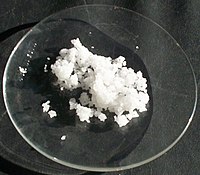
Photo from wikipedia
The synthesis of three catalytic samples of MgO–CaO containing 20, 30, 50 wt% of CaO was carried out by a co-precipitation method. Also pure MgO and CaO were prepared. Infrared… Click to show full abstract
The synthesis of three catalytic samples of MgO–CaO containing 20, 30, 50 wt% of CaO was carried out by a co-precipitation method. Also pure MgO and CaO were prepared. Infrared spectroscopy, Raman, X-ray photoelectron, X-ray diffraction, atomic force microscopy and Temperature-Programmed Desorption of CO 2 characterized powder samples. Those analyses permitted to differentiate phases in mixed oxides in catalysts and to identify phases that gave a basic character to solid samples. The powders were used to catalyze the acetylation of glycerol to produce mono, di and triacetin at 70 °C during 280 min. The reaction products were followed by IR, and gas chromatograph analysis. The highest glycerol conversion (89%) was attained by using 50MgO–50CaO catalytic sample, while pure MgO exhibited the poorest conversion (of c.a. 64%). Regarding selectivity toward triacetin, the catalyst containing 50 wt% CaO was the best, reaching a value of ~ 92%, while yielding the lowest diacetin and monoacetin (0.5 and 5%, respectively). Despite the catalyst types, triacetin selectivity profiles showed increased as reaction time did, whereas diacetin underwent a continuous decrease and monoacetin remained almost constant with the reaction time. The study results demonstrated that MgO–CaO mixed oxides provided a synergetic effect in glycerol acetylation in terms of both conversion and selectivity to valuable products.
Journal Title: Reaction Kinetics, Mechanisms and Catalysis
Year Published: 2020
Link to full text (if available)
Share on Social Media: Sign Up to like & get
recommendations!